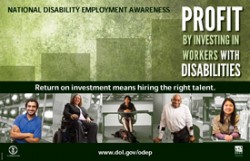 Falguni Chitalia, a native of India, speaks three languages and holds a degree from Rutgers. She also has cerebral palsy that has affected her speech and limited the use of her left hand.
Falguni Chitalia, a native of India, speaks three languages and holds a degree from Rutgers. She also has cerebral palsy that has affected her speech and limited the use of her left hand.
She struggled to earn a living, for a time clerking at Wal-Mart. But her goal was to find work as a professional in a career that could allow her to be independent. With the assistance of Virginia’s Department of Rehabilitative Service, Chitalia received job counseling and speech therapy.
Today, she is a project manager with Anthem Wellpoint and was recently lauded in the company newsletter.
Her story is but one of dozens being cited as examples of the success disabled workers can have when, with a little assistance from the government, employers reach out to the disability community.
October is National Disability Employment Awareness Month. The U.S. Department of Labor is taking the lead in promoting the month around the theme of “Profit by Investing in Workers with Disabilities.” Managed by the DOL’s Office of Disability Employment Policy, the month-long campaign to build awareness of the contributions of the disabled includes the posting of stories like Chitalia’s, as well as lending support to state and local efforts to increase the hiring of disabled workers.
Despite laws prohibiting discrimination in hiring against people with disabilities, the latest data from the U.S. Bureau of Labor Statistics puts the unemployment rate for disabled persons at 16.1 percent, compared to 8.5 percent for persons with no disability. While the unemployment for the bulk of the population declined from 9 percent in September 2010, it increased from 14.8 percent for the disabled.
An even more telling statistic is the percentage of the disabled who are in the workforce, whether working or looking for a job. Only 21.1 percent of disabled persons are considered in the workforce, compared to 69.7 percent of the population without a disability.
When you look at unemployment rates and workforce participation for other protected worker classes — by sex, age, ethnicity — there are disparities, but few as wide as for the disabled. (Young workers and black males are the leading exceptions in the unemployment rate spread. But even among the youngest workers, their participation in the workforce is higher.)
Why the gulf when it comes to the disabled? In a study of the issues affecting the hiring of the disabled, a group of scholars found employer attitudes had much to do with the low employment rate. “While employers tended to espouse positive global attitudes toward workers with disabilities, when specific attitudes related to the hiring of this group were assessed, views were more negative,” the researchers wrote.
“It is apparent that an overarching concern among employers has been that the costs associated with hiring people with disabilities will outweigh the benefits,” they said.
The evidence suggests that the cost issue is largely a red herring. Studies going back several years show the cost of making accommodations for disabled workers was almost insignificant. The most current data — from the Job Accommodation Network — says 56 percent of the employers participating in the survey reported no cost to accommodate a disabled employee; 38 percent reported a one-time cost they estimated at $500.
Other studies have found that the benefits of hiring disabled workers outweigh the costs, even when they are at the top end.
At an April conference organized by the U.S. Chamber of Commerce, its president and CEO said, “Individuals with disabilities make great employees. In fact, employers report that the work ethic of disabled employees has a positive effect on the morale and production of other employees.”
(The Chamber has a free, best practices booklet — Leading Practices on Disability Inclusion — that highlights the inclusion programs of several companies.)
Besides the cultural effects and the productivity gains, there are also tax benefits to hiring disabled workers. Small businesses can take up to $5,000 off their tax bill for costs related to providing accessibility for their disabled workers. Hiring certain qualified disabled persons may be able to claim a $2,400 credit; double that if the disabled person is a veteran.
Many states offer their own incentives as well as providing vocational and rehabilitative services for disabled workers. Last month the Department of Labor awarded seven states a total of $21 million in grants under the Disability Employment Initiative.
If the carrots don’t work, there’s one other reason to seek out and hire the disabled: enforcement by the Equal Employment Opportunity Commission. Disability claims at the EEOC have been rising steadily since 2004, when the number hit a low of 15,376. Last year there were 25,165, the EEOC reports.
Today, disability charges account for a quarter of the individual charge filings. Additionally, in 2010, the EEOC collected $76 million on behalf of aggrieved individuals.
However, the point of National Disability Employment Awareness Month is not to emphasize the legal obligations, but to encourage employers to consider the benefits and dispel the concerns, legitimate or otherwise, of employers about hiring the disabled.
The authors of the study mentioned earlier note in their research report that, “though benefits are considerable, the employment rate for people with disabilities remains low. This gap suggests the pressing need to educate the business community about the benefits of having a disabled workforce, and how these benefits may outweigh perceived costs.”
Or, as Jennifer Woodside, president of The Disability Training Alliance, says, “Because of the looming labor shortage which will happen in the next decade, companies must be visionary, prepared to recruit a native talent pool and welcome an under-served demographic in their communities: qualified, highly educated candidates, including STEM (science, technology, engineering and math) grads and combat injured veterans who just happen to have a disability.”